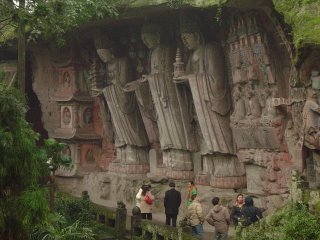Final Essay for Comparative Religion
Thank you Amy for all your work you do. I would also like to thank Rev. Kythera Ann for writing and teaching this course. It was very interesting and informative. I would definitely take another course from Rev. Kythera Ann. I can hardly wait until part 2. I had a difficult time just waiting week to week for this course. I HIGHLY recommend this course to everyone who plans to work in any type of ministry. This course covered so many aspects of religions, their symbolism, rituals, history and much, much more.
Rev. Kythera Ann included hundreds of color pictures to go along with the subject being covered. The pictures help to understand the subject matter. The recommended readings and the extra web sites were awesome. I built up an excellent library of resources and read a great number of the recommended books. I enjoyed and learned a great deal from these resources. For example, one site was the Peace Pole Project. I had never heard of it. When I checked into it I found a nearby city that had a Peace Pole. That lead me to talk to locals about it and I gained even more information.
Rev Kythera Ann’s knowledge of this course was impeccable. I gained insight in religions I never heard of. There was one religion, Zoroastrian, I’ve wanted to learn more about. Having a Zoroastrian acquaintance from India, she often spoke of her religion. Now I’ve gained new insight into her life.
I now have a very extensive library on world religions. So many books I’d heard of but never took the time to read until this course. It’s been educational and fun.
The history of these religions and the battles and sufferings people went through just to bring their beliefs out into the open.
The thing I liked least about this course was that it had to end after 20 discourses. I could take this course on a regular basis. These discourses are perfect. They were a great length and had great photos and other resources to back them up. I don’t think you could make them any better.
My favorite part in this course (which is hard to pick one) was on symbolism. The use of symbolism is apparent in every religious tradition. It is an important part of most religions. As Philip Rawson said about the symbolism of Indian Art "All religions include a clutch of interwoven "fossil" symbols. These basic symbols serve to structure otherwise inexpressible intuitions about the origin, meaning and destiny of the human world, and guide people’s behavior as well as their spiritual effort. Symbols link together experience at personal, social and cosmological levels." Carl Gustav Jung pioneered the psychology of symbolism. Jung stated that some symbols were of universal significance. Important parts of psychic process influence every aspect of human thought and endeavor.
Geometric forms in religions are important. One is the circle, which is the beginning and the end and has no end or direction. Often a serpent is used for the circle. One example is the Ouroboros, a snake swallowing its tail. Often a serpent is used for the circle. The Ouroboros is a Greek word meaning "tail swallower". It is usually circular, although sometimes it is in a lemniscape shape. It originated in Egypt as a symbol of the sun and represents the travels of the sun disk. In Gnosticism, it was related to the solar God Abroxas and signified eternity and soul of the world. One other circle is the Buddhist Wheel of Law and in Zen Buddhism the circle stands for enlightenment and the perfection of humanity in unity with the primal principles. In history the circle becomes a symbol of divinity. It is also seen in western art. It has seen around Jesus and the Apostles at the Last Supper, Saints, and many religious figures. Even today on food or cleaning projects halos are used. Such items include Uncle Ben’s rice, Sun Maid raisins, Tide, and Mr. Clean.
Other symbols are the Axis Mundi, circumanbulation, the cross, the ankh, triangle and squares. There are even combined uses of symbols like the Celtic cross. In Northern Europe, Egypt, the Middle East and China the circle is female and the cross is male and stands for union. A cross, inscribed within a circle, is used in Native American traditions. This symbolically means the connection of sky and earth. The circle combined with a square is supported by the Buddhist mandala, in which squares inside circles represent the passage from material to spiritual planes. There are many, many more symbols.
As you can tell I get very excited talking about this course. It was wonderful and Rev. Kythera Ann was a great teacher.
In Christ Jesus name,
Rev. Nancy Rutledge
*******************************
The Universal Life Church is a comprehensive online seminary where we have classes in Christianity, Wicca, Paganism, two courses in Metaphysics and much more. I have been a proud member of the ULC for many years and the Seminary since its inception.
The Universal Life Church offers hand-fasting ceremonies, funeral ceremonies and free minister training.
As a long time member of ULC, Rev. Long created the seminary site to help train our ministers. We also have a huge selection of Universal Life Church minister supplies. Since being ordained with the Universal Life Church for so many years and it's Seminary since the beginning, I've watch the huge change and growth that has continued to happen.
Try our new free toolbar at: ULC Toolbar







No comments:
Post a Comment